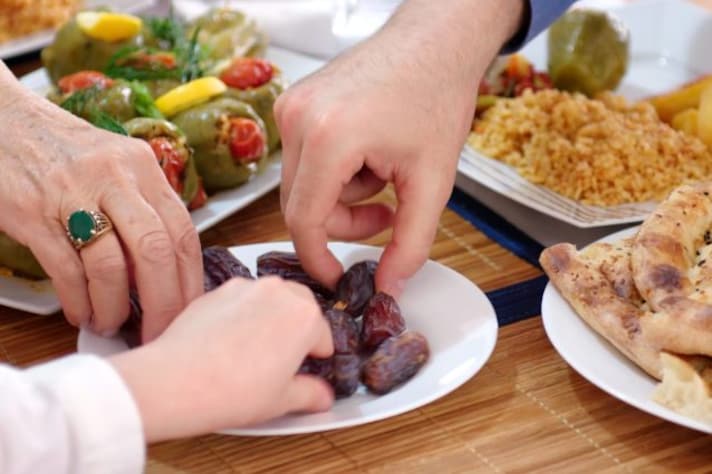
We are in the month of Ramadan, that period of fasting and purification in which Sawm is practiced in commemoration of the first revelation of the Koran to Muhammad by the angel Gabriel. In an increasingly multi-ethnic world, Ramadan is now known to everyone, but saying that it is "the month in which Muslims fast" is simplistic to say the least. First of all because it is part of a centuries-old religious tradition, and then because fasting occurs during the day, but you can eat from sunset. Let's see all the gastronomic traditions linked to Islamic commemoration.
What is Ramadan
First of all, let's explain what Ramadan consists of and why it always falls in a different month. The Islamic calendar is based on the motion of the Moon, starts from Friday 16 July 622 of the Julian calendar, the date on which the Heigra was completed by Muhammad, and is divided into 12 lunar months of 29 or 30 days; a year lasts 354 days and, approximately every three years, one more day. For this reason, just like Christian and Jewish Easter, there is never a precise date in the celebration.
In Islam, Ramadan is celebrated in the ninth month of the year and lasts 29 or 30 days, depending on the observation of the crescent moon. This annual event is considered one of the Five Pillars of Islam and fasting is a relicious precept for adult Muslims. All elderly people, pregnant, breastfeeding or menstruating women, diabetics, terminally ill patients and children are exempt from fasting.
At the end of Ramadan, Eid al-fitr is celebrated which means "festival of breaking the fast", the second most important holiday in Islam. Ramadan 2024 begun in the evening of March 10th and will end on Tuesday, April 9th, according to lunar calendar calculations.

What to Eat During Ramadan
During the fasting month there are two main meals, one just before dawn, the suhur, and the other immediately after sunset, called fitùr or iftar. Suhur is a very light meal, sometimes it consists of a simple sip of water, but the choice is free: it depends on how much you ate during the night. However, you can eat a classic breakfast, ranging from cereals to yogurt or fresh fruit, depending on the tradition of the country in which you live. There aren't many restrictions on this.

Iftar is instead celebrated at sunset: it begins by eating a date in memory of the way in which the prophet Muhammad broke his fast.Usually three courses alternate, the first consisting of an odd number of dates followed by water, to be drunk in small sips and then doing the Maghrib prayer.
Once this ritual is over you can eat peacefully; iftar usually starts with a soup based on lentils, chicken, oats and potatoes. The last course is generally the most abundant and varies depending on how hungry the faithful are. In this phase Muslims also begin to consume cold drinks to quench their thirst, if the fast is occurring during a hot period. At night you can treat yourself to some fruit, some sweets or drink fruit juices.
This abundance is not a simple binge designed to recover the calories lost during the day: every dish must be served and eaten with decorum and moderation, without over exaggerating, in fact all those excessively fatty foods are viewed with great suspicion. You need to eat just enough to quell your hunger.

What has been described so far are generic suhur and fitùr, common more or less throughout the world, but in some countries things are different.
In Bangladesh, for example, to celebrate Iftar, a huge amount of food is prepared. First of all we find the typical dishes of Bengali cuisine such as jalebi, beguni or piyaji. Also typical are yellow lentils boiled in water enriched with onion, garlic and chili pepper. The samosa is never missing, one of the most famous dishes in Indian cuisine, which has however conquered all the surrounding areas. The most usual drinks are lemon sharbat, a kind of sorbet with a thick consistency, and Rooh Afza, a commercial drink made from fruit and herbs.

The Indian variant of iftar is also very interesting, the preparations for which begin many hours before, both in the homes of the faithful and in the city markets. There are some differences between the Southern and Northerns states: in the first case, Muslims usually break their fast with nonbu kanji, a dish based on rice, coconut, dhal (a mixture of dried legumes) and mutton. In South India there are many vegetarians and the latter replace the abundant dish with surkumba, a sort of sweet pudding made with milk. In the North of the country, however, the meal opens with traditional dates, followed by fresh fruit; the third course is instead based on fried foods and the most important dish is the samosa.
The nation that has the most restrictions on Ramadan meals is Iran: here the range of foods available for Iftar is really limited. The most common elements of the meal are: čai (a tea), nun bread, panir (a cheese), fresh vegetables, some traditional desserts and, of course, the ubiquitous dates.
;Resize,width=767;)
